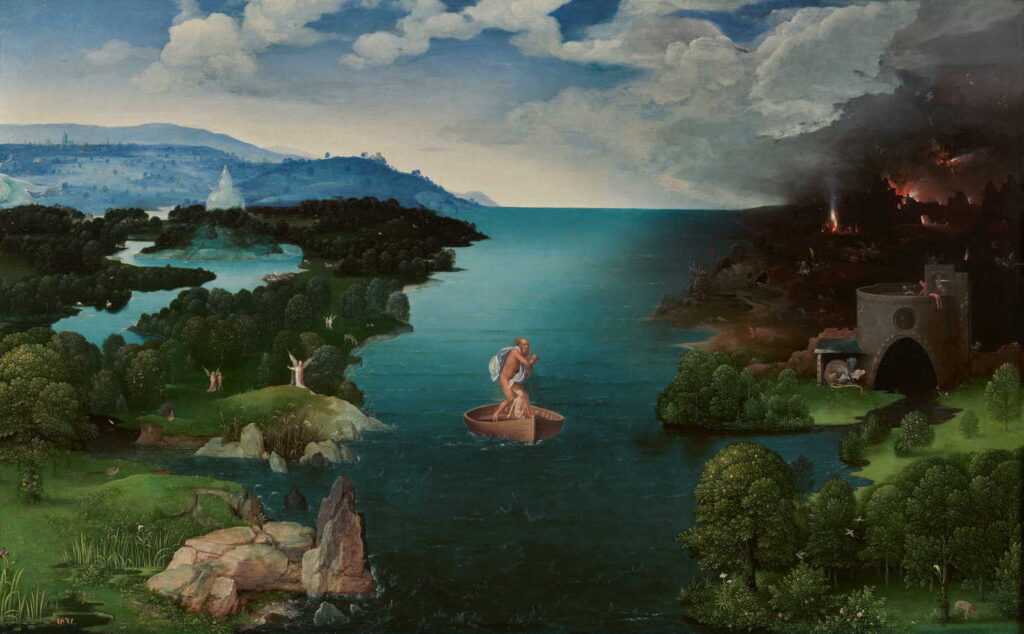In memoriam Joachim Patinir, who died 500 years ago

Five hundred years – half a millennium – ago today, the pioneering landscape painter Joachim Patinir died in the city of Antwerp. A friend of Albrecht Dürer, and contemporary of Albrecht Altdorfer, like them he was one of the first serious landscape artists in Europe, and is thought to be the originator of the World View, a forerunner of the panorama.
Patinir was born in about 1480 in the town of Dinant or Bouvignes, not far from Brussels in modern Belgium. He may have been an apprentice to Gerard David in Bruges, and first registered as a Master in his own right in the Guild of Saint Luke in Antwerp by 1515. Between then and his death in Antwerp on 5 October 1524, he led a large workshop and appears to have been productive if not prolific. However, only five of his signed paintings have survived, with a total of as many as 29 being attributed to him or members of his workshop.
Most of his surviving paintings are at heart landscapes, incorporating a scene from a religious story in their foreground to satisfy the expectations of his patrons.
Joachim Patinir (c 1480–1524), Landscape with St John the Baptist Preaching (c 1510), oil on oak wood, 36.5 x 45 cm, Koninklijke Musea voor Schone Kunsten van België / Musées Royaux des Beaux Arts de Belgique, Brussels, Belgium. Wikimedia Commons.
He is thought to have completed this Landscape with St John the Baptist Preaching in about 1510, when he was thirty, and had probably only recently registered as a Master with the Guild. Already, he is using repoussoir with the foreground tree at the left, and has exaggerated aerial perspective to make its horizon appear almost infinitely deep. This is the start of the World View.
Joachim Patinir (c 1480–1524), The Penitence of Saint Jerome (triptych) (c 1512), oil on panel, central panel 117.5 x 81.3 cm, wings 120.7 x 35.6 cm, Metropolitan Museum of Art, New York, NY. Wikimedia Commons.
Patinir may have enlisted the help of his friend Quentin Matsys when painting this triptych of The Penitence of Saint Jerome in about 1512. The left wing shows Christ being baptised by John, with the penitent Jerome in the centre panel, and the temptation of Anthony in the right wing. The landscape is continuous across the three panels, with exaggerated aerial perspective again, and the red clouds of dawn or dusk in the centre. Among the animals featured in the distance beyond Jerome is a fully laden camel.
Joachim Patinir (c 1480–1524), The Baptism of Christ (1510-20), oil on oak wood, 59.7 x 76.3 cm, Kunsthistorisches Museum, Vienna, Austria. Wikimedia Commons.
The Baptism of Christ from 1510-20 is a fully developed version of the left wing in that triptych employing similar details, such as the Holy Ghost, in the form of a white dove, flying down from God the Father in the heavens above. In the left background, John is preaching in a recapitulation of his earlier Landscape with St John the Baptist Preaching above.
Joachim Patinir (c 1480–1524) and Quentin Matsys (1466-1530), Temptation of St Anthony (c 1515 or 1520-24), oil on panel, 155 x 173 cm, Museo Nacional del Prado, Madrid, Spain. Wikimedia Commons.
Patinir is known to have joined forces with Quentin Matsys (1466-1530) in their Temptation of St Anthony, either from about 1515 or 1520-24, where Matsys is believed to have been responsible for the figures in the foreground. Anthony is being taunted and tempted by a small devil behind him, a trio of beautiful women, and an ugly old hag to the left. Suitable cameos are embedded in the landscape, and there appears to be a war going on up in the dark clouds overhead,
Joachim Patinir (c 1480–1524), The Rest on The Flight into Egypt (1515-1524), colour on wood, 62 x 78 cm, Gemäldegalerie der Staatlichen Museen zu Berlin, Berlin, Germany. Wikimedia Commons.
The Rest on The Flight into Egypt from 1515-24 features Mary with the infant Jesus on her lap, and Joseph’s traditional walking stick, although he is missing from the family group. The landscape is Netherlandish, with a major port town in the right distance, and a windmill closer. It also incorporates one of Patinir’s distinctive landscape forms, the castle nestling inside a rock pinnacle in the upper centre. That reappears in several of his imagined landscapes.
Joachim Patinir (c 1480–1524), Landscape with the Destruction of Sodom and Gomorrah (c 1520), oil on panel, 22.5 x 30 cm, Museum Boijmans Van Beuningen, Rotterdam, The Netherlands. Wikimedia Commons.
His Landscape with the Destruction of Sodom and Gomorrah from about 1520 is perhaps more reminiscent of his near-contemporary Hieronymus Bosch. At the right edge, the Lot family are making their escape with the aid of angels, as the cities burn behind them. The cameo scene in a tent above them might show the temptation of Lot by his daughters.
Joachim Patinir (c 1480–1524), Crossing the River Styx (1520-4), oil on panel, 64 x 103 cm, Museo Nacional del Prado, Madrid. Wikimedia Commons.
His famous Crossing the River Styx (1520-4) is unusual for its mythological scene, including fire and damnation in Hell on the right. It’s perhaps his ultimate World View: the spectator is elevated above the surface and looks on and down over a richly-detailed landscape stretching to the far horizon.
There is some confusion, though. In classical mythology, the River Styx separates the earthly world from that of Hell. Here Patinir appears to show Charon the boatman navigating between Hell, on the right, and an Elysian vision, complete with angels, on the left. This may reflect an adjustment of myth to incorporate the Christian dichotomy of heaven and hell.
Although Patinir paints a crisp and clear horizon to the sea, he uses marked aerial perspective for the land on the left, making it recede into distant haze, to give the feeling of great depth of view, one of the key features both of the World View style and of panoramic landscapes more generally.
(Attr. Joachim Patinir), The Battle of Pavia (c 1530), oil, 32 x 41 cm, Kunsthistorisches Museum, Vienna. Wikimedia Commons.
This wonderful World View of The Battle of Pavia has been attributed to Patinir, although there are strong reasons for disbelief, in that he is recorded to have died on 5 October 1524, but this battle didn’t take place until the morning of 24 February the following year. It does, though, follow Patinir’s lead with its World View.



